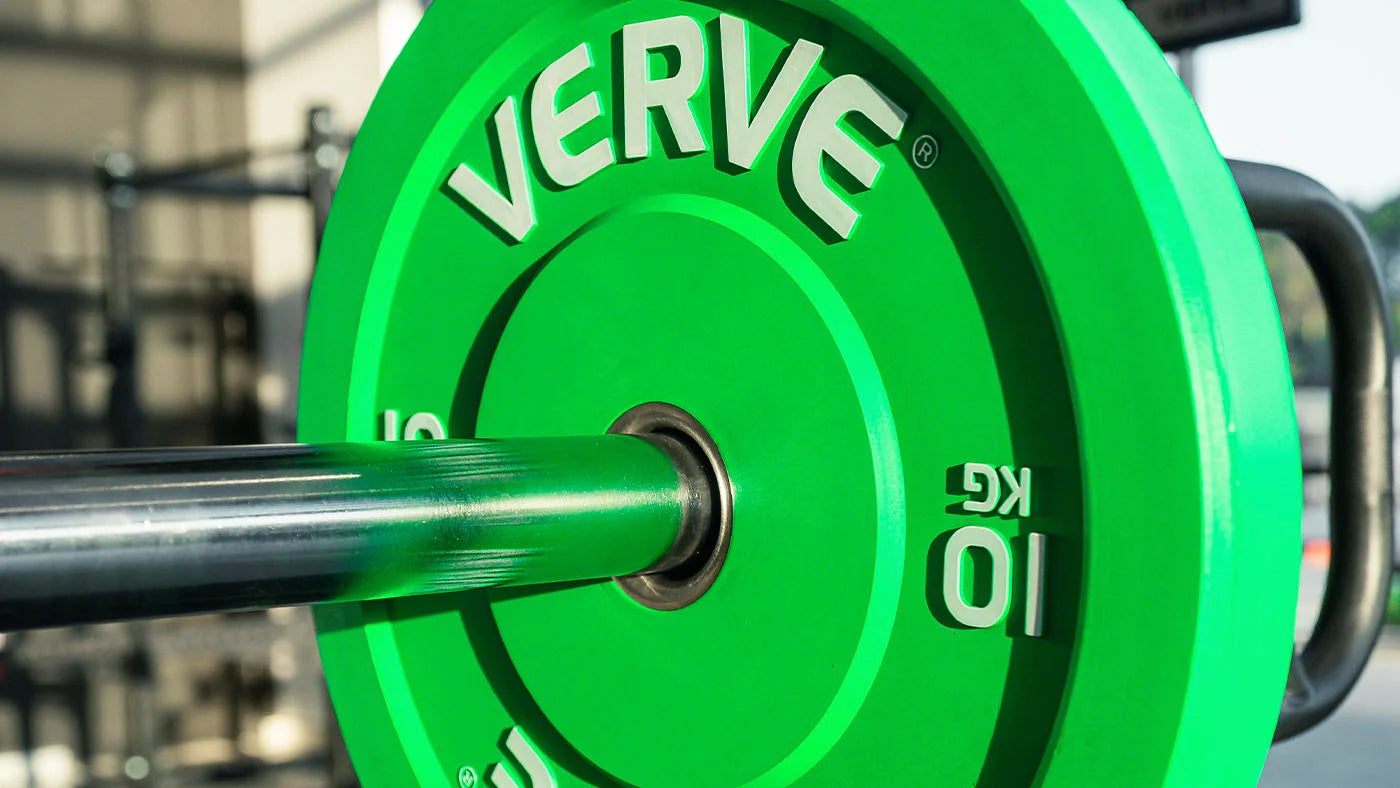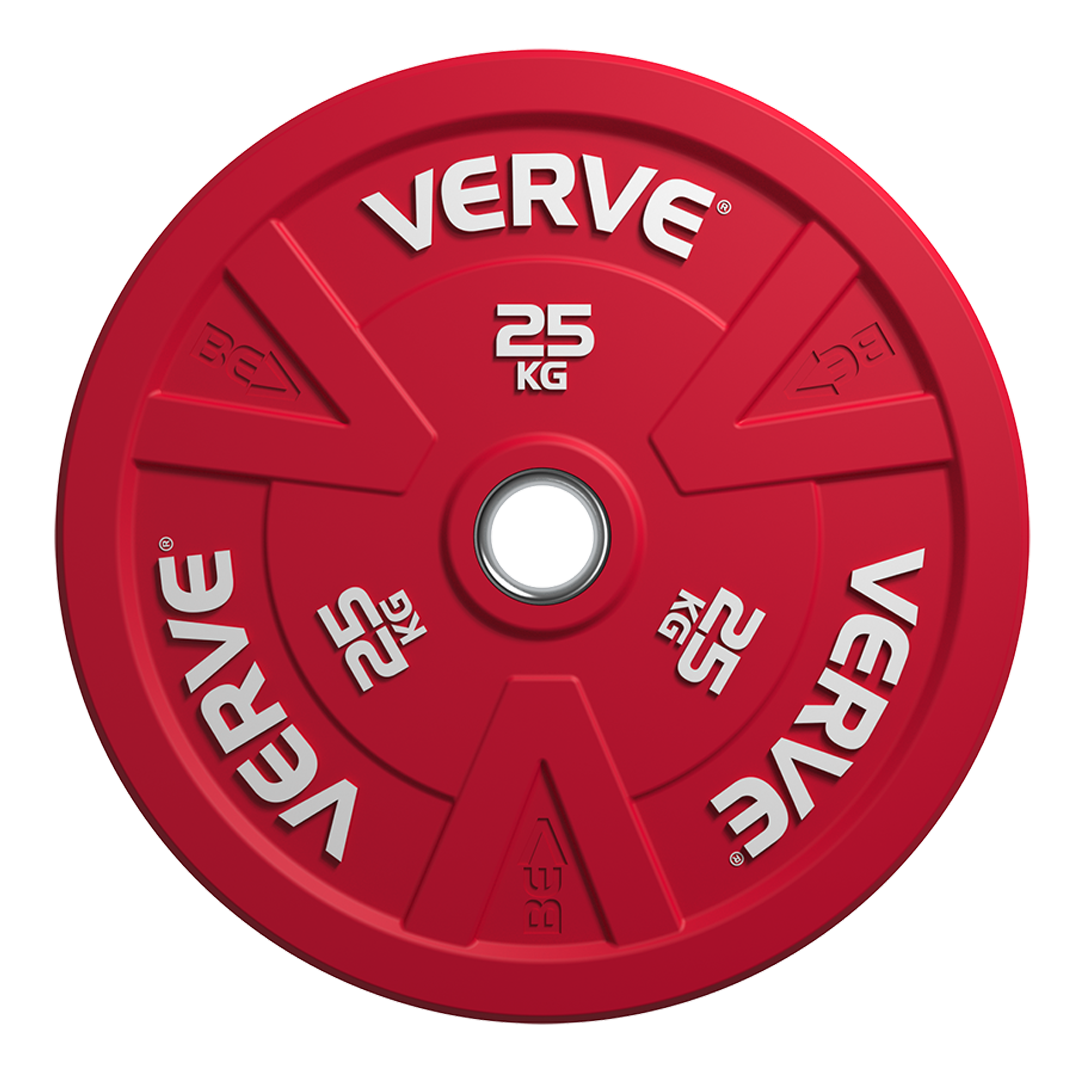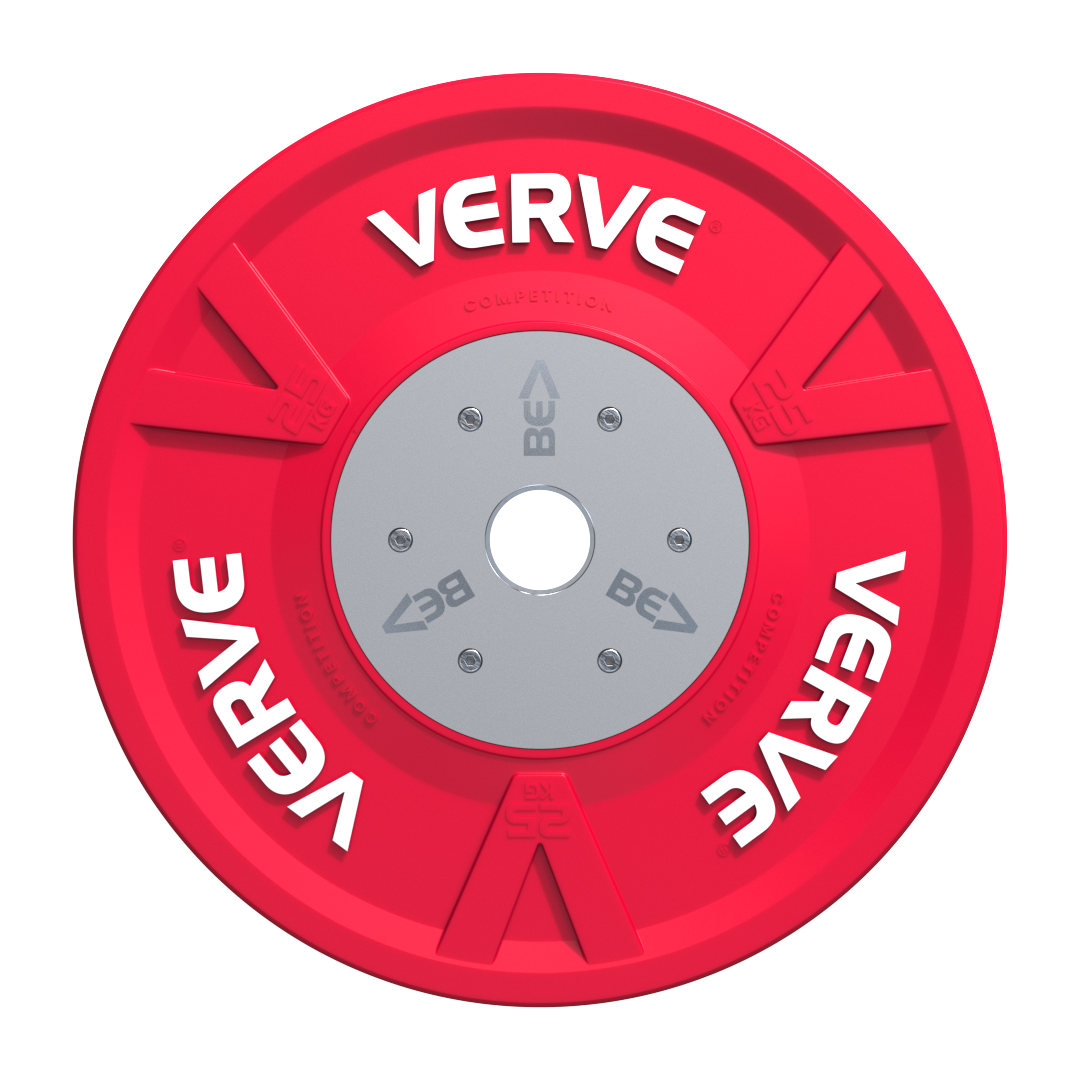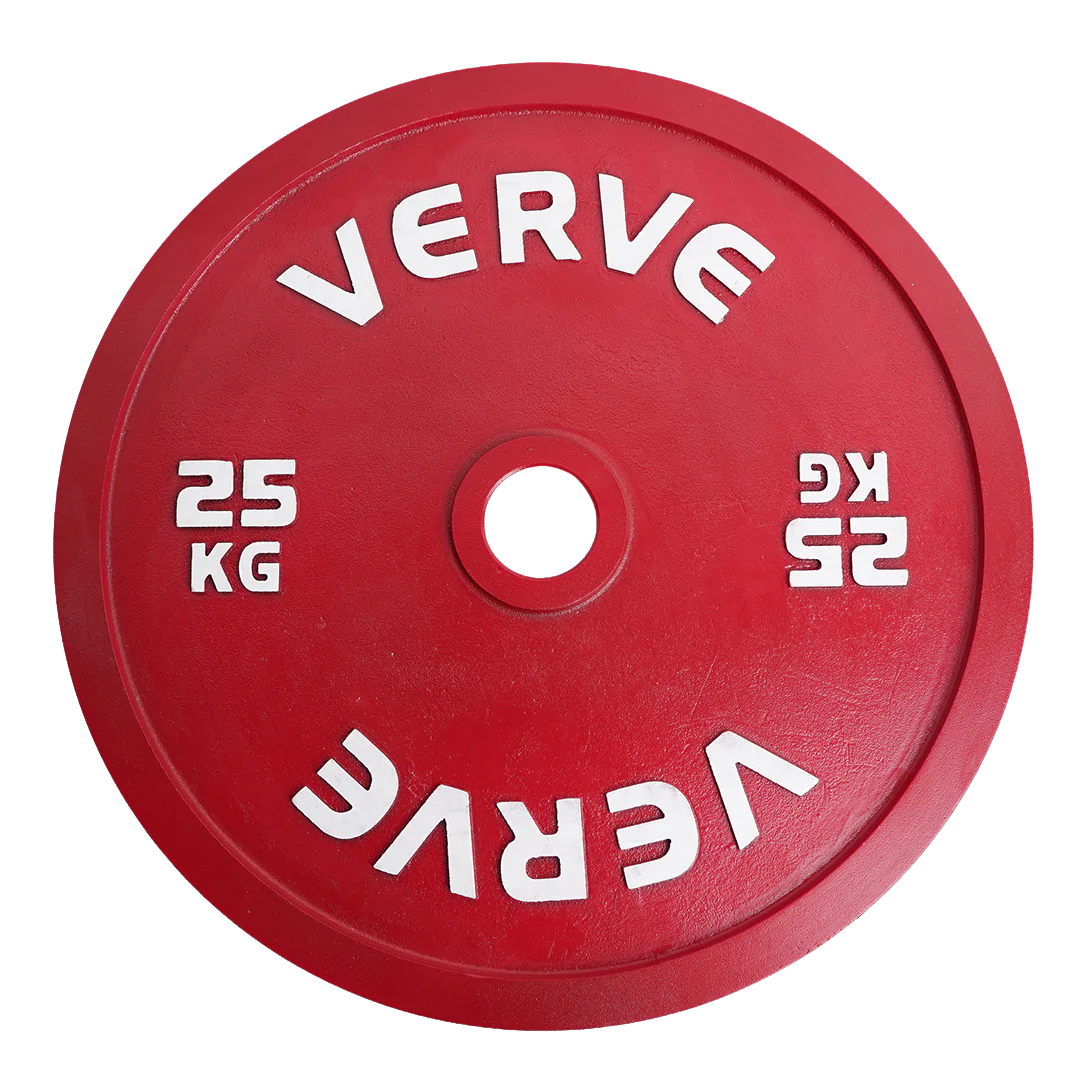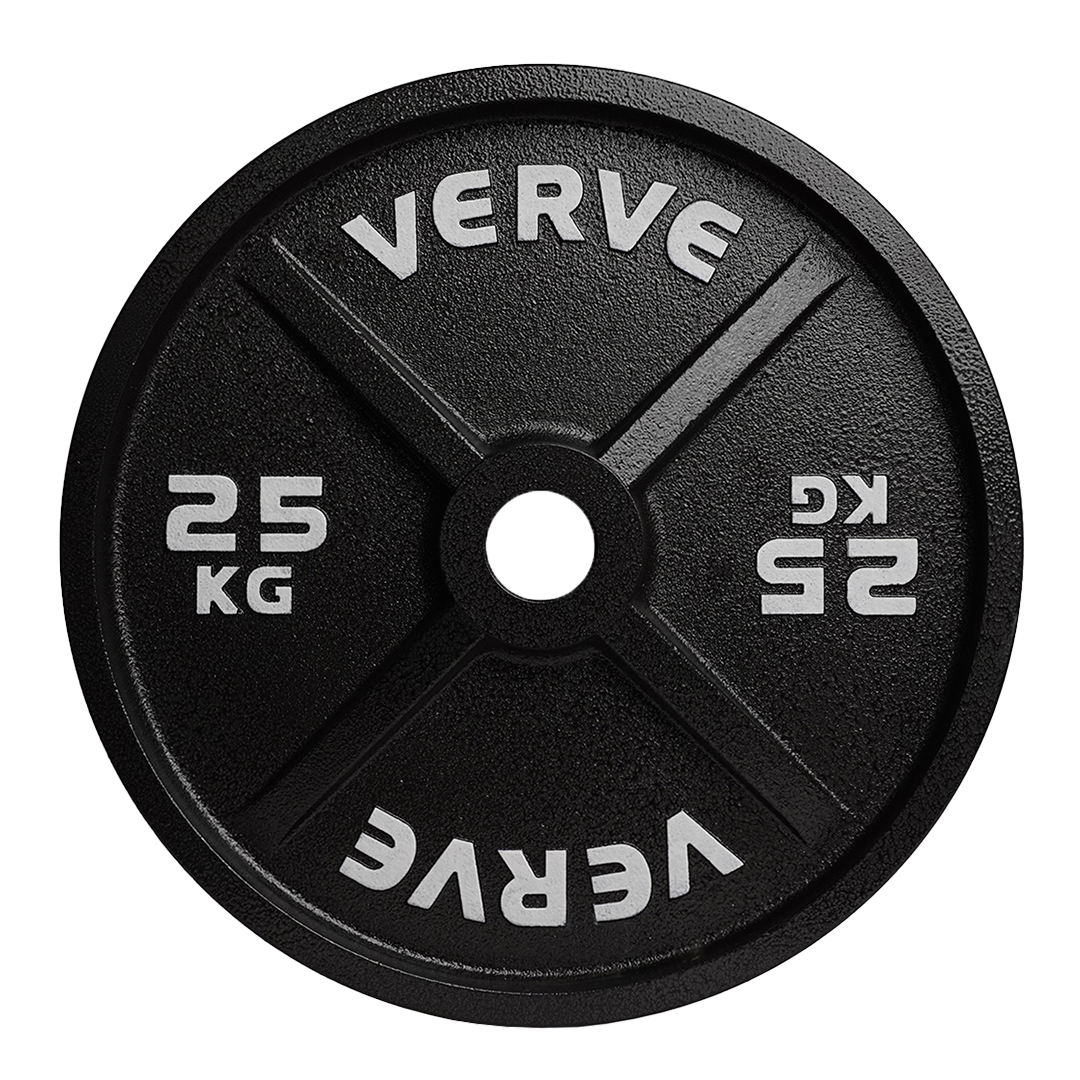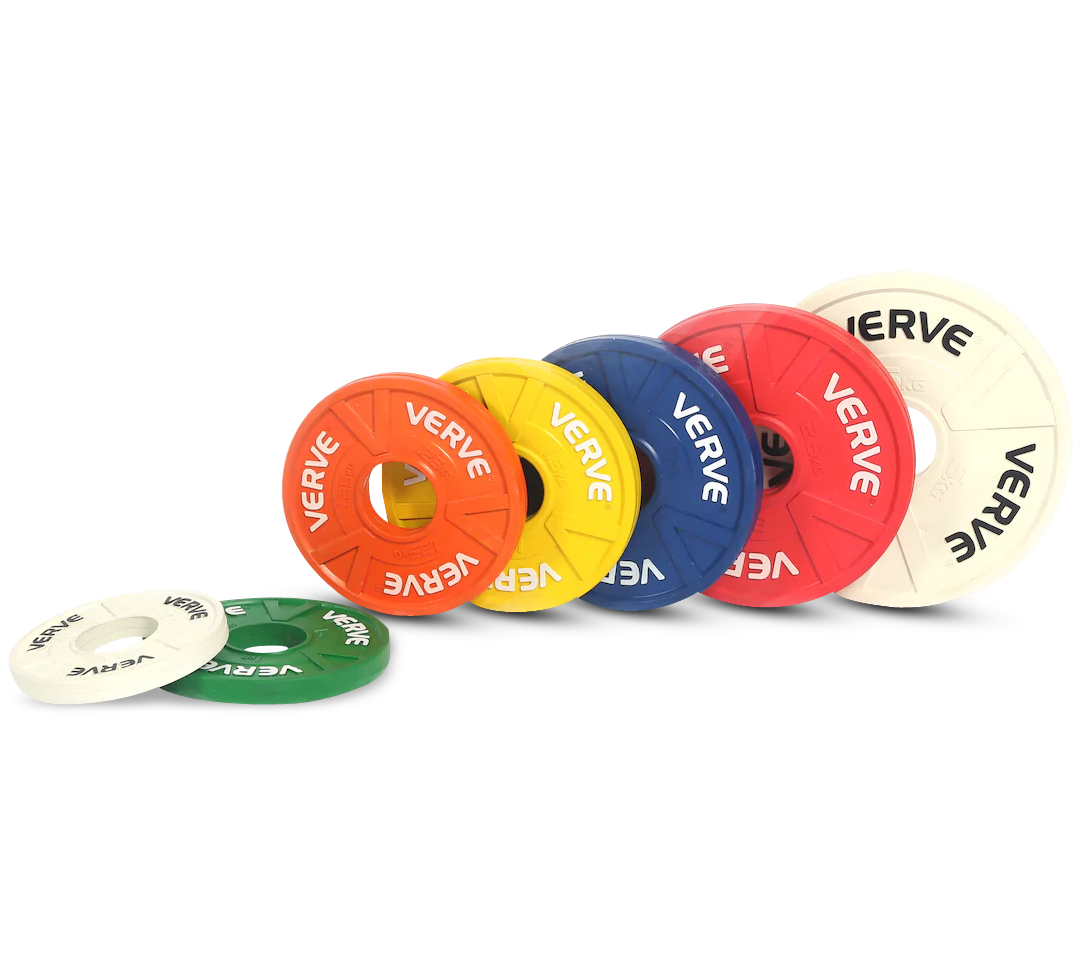In the world of fitness, we all know that 10kg is the same weight regardless of where you are. But when it comes to purchasing weight plates for your gym or fitness centre, there are several factors to take into account.
That's why this Weight Plate Buying Guide will serve as an invaluable resource for any buyer looking to make an informed decision. This guide offers comprehensive information on weight plates to help you choose the right ones that cater to your needs. We’ll discuss:
Whether you're a gym owner in the fitness industry or an individual who wants to achieve your fitness goals, we highly recommend reading through this guide before making any purchases. It will undoubtedly save you from potential headaches down the line.
Weight Plate Hole Sizing
When it comes to weight plates, hole sizing is actually pretty important. The hole in the centre of the weight plates is what allows you to slide them onto a barbell or other weight-lifting equipment. If the holes aren't the right size, the plates won't fit properly, which can cause all sorts of problems.
Generally speaking, weight plates come in three sizes: Standard, Studio and Olympic. And we will discuss these below:
Standard Size: 25mm diameter
Standard-sized plates are a common choice for people setting up a beginner home gym. You can find them in many stores that aren't specialised in fitness equipment. They can be a great option for people who are just starting out with strength training or for those with limited experience.
However, it's important to note that standard-sized plates aren’t suitable for performing heavy compound lifts. This is because the size of the hole is suited to standard bars that are not compatible with lifting heavy weights. If you're looking to lift heavy weights and do exercises like squats or deadlifts, you will need to invest in larger plates that can provide more weight.
The best type of weight plates for you will always depend on your specific fitness goals and needs. If you're just starting out or have limited experience, standard-sized plates may be a good place to start. But if you're looking to get serious about strength training and performing heavy lifts, you will need to consider purchasing larger plates.

Studio: 30mm approximately
You may recognise these bright-coloured plates from studio classes, as they are often used in programs like Body Pump. Studio weight plates are typically smaller in size and have a lighter weight than other types of weight plates. They are designed to be used in fitness sessions that require a high amount of reps over a short period, such as HIIT workouts with weights.
While they are perfect for classes and group workouts, studio bars and plates are not as practical for heavy lifts on the gym floor. If you're looking to do exercises like squats, deadlifts, or bench presses with heavy weights, you will need to invest in Olympic plates and an Olympic barbell that can handle the load.

Olympic: 50mm Diameter
Olympic plates are used in Olympic weightlifting, powerlifting, bodybuilding, functional fitness and just about every part of the weightlifting spectrum. All VERVE-branded weight plates and barbells are Olympic-size.
You have most likely used or seen Olympic-size weight-lifting plates before. They can be made from a range of different materials, which we will dive into.

Note: One thing to keep in mind is that not all weight plates are created equal. Some plates may have slightly larger or smaller holes than others depending on the brand. This can be frustrating, as it can make it difficult to get a snug fit on your barbell. To combat this issue, using the same supplier when buying your gym equipment is your best option. Alternatively, doing your research before making a purchase can help with making sure that your gear will be compatible.
Overall, weight plate hole sizing is an important consideration when it comes to weight lifting. By making sure you're using the right size weight plate for your equipment, you'll be able to lift more safely and effectively, and you'll avoid any potential damage to your equipment.
Weight Plate Materials (Olympic Size)
Weight plates are available in a variety of materials, each with its own advantages and disadvantages. It’s important to consider the differences in material, as this can play a vital role in how they are used. Here are a few of the most common materials used for weight plates:
1. Iron
Generally speaking, most plates tend to be made from cast iron, hence why the phrase “pumping some iron” has been around for decades. These are most commonly used as they are cheaper and last a lifetime.
2. Steel
Steel is an alloy, meaning it is stronger and more durable than iron. Steel usually is more expensive due to its strength and durability.
3. Chrome
Though weight plates are unlikely to be made out of pure chrome, some high-end plates do come with a dipped chrome coat. Chrome helps the weight plate last longer, as well as adding a nice finish to the plate. Additionally, chrome is usually used in steel production, so some steel plates will contain some elements of chrome.
4. Rubber
Not to be confused with rubber-coated weight plates, rubber is used in creating bumper plates, which are the weight plates used in Olympic Lifting. Rubber enables the lifter to drop the weight safely in front of them while also lowering the risk of damaging any equipment.
5. Rubber-Coated
Rubber-coated plates are made out of either iron or steel and then a coat of rubber is added on top. This is to increase durability and safety while also being slightly better for the floor. Rubber-coated plates are very common in gyms and are known for being quite robust.
6. Urethane Coated
Urethane is much more durable than rubber, meaning it is a lot less likely to get damaged and will last longer. However, longer durability equates to a higher price.
7. Cement-Filled Plastic Plates
Cement-filled plastic is typically used for standard-sized plates, but it can be found in Olympic-sized plates too. This type of weight plate is not recommended for serious lifters as its thickness prevents the number of weight plates that can be loaded onto the bar. Additionally, heavy lifting may cause the plastic to crack. In our opinion - these plates are best to be avoided.
As we mentioned earlier, when choosing weight plates, it's important to consider the type of lifting you will be doing, your budget, and your personal preferences. Some people prefer the traditional look and feel of cast iron plates, while others prefer the quieter, more modern look of rubber-coated plates.
Ultimately, the most important thing is to choose weight plates that are safe and effective for your particular fitness goals.
Types of Weight Plates
So, we've talked about the different sizes and materials available for weight plates, which is a good starting point. But, it's also important to consider some other specifics when choosing weight plates that are right for you.
1. Bumper Plates
Although bumper plates are made of rubber, they should not be confused with rubber-coated plates. Make sure you check before purchasing as they can sometimes look quite similar. Bumper plates are best used in performing Olympic lifts, as they can be safely dropped from an overhead stance.

Bumper plates either come in a variety of colours or pure black. Colour plates allow spectators to easily calculate how much weight a competitor is lifting. For example, grey is 5kg and red is 25kg.
It is best to bear in mind that bumper plates do have a few variants, as detailed below:
- Normal Rubber Bumper Plates: These plates are made of rubber and are commonly used in all Olympic weightlifting practices. When purchasing a standard bumper plate, be sure to get one with an iron or steel ring in the middle, as this will allow you to easily move plates on and off the bar without “sticking” along the way. Black is generally used in training and colours are reserved for competition purposes.
- Hi-Temp Bumper Plates: Hi-Temp are generally just as durable as normal bumper plates, but they can be a little bit more expensive. The major difference is that they can have an extreme bounce after being dropped. This means there is a risk of them bouncing onto you or someone nearby.
- Calibrated Competition Bumper Plates: These plates are mainly used in competition. Calibrated means the plate weight is as accurate as possible; this is something that is very important in the Olympics, but less so for your average gym-goer.
- Urethane Bumper Plates: Urethane is more durable than rubber, but this comes at a much higher price.
- Technique Bumper Plates: Technique Bumper plates are the same as normal bumper plates, however, they come in low weights of under 5kg. This enables someone to emulate a heavy deadlift but only lift low weights, such as 2.5kg.
2. Steel and Iron Plates
When it comes to weight plates, there are two main types: iron and steel. Steel is more durable but also more expensive.
Some plates have a rubber coating, which can protect them from wear and tear. Just make sure to check if the plates are designed to be dropped on the floor because some can be damaged that way.

To recap, there are two types of weight plates are as follows:
- Calibrated Steel or Iron Plates: Again, calibrated means the weight is as accurate as possible, mainly used in competitions. They come at a higher price and are generally thinner, meaning more plates can be loaded onto the bar.
- Normal Iron or Steel Plates: A traditional weight plate that has been widely used for decades. Think of every picture of Arnold Schwarzenegger you’ve ever seen.
Overall, just choose plates that fit your needs and budget, and that will help you reach your fitness goals.
3. Tri-Grip Plates

Tri-Grip plates are a type of weight plate used in weightlifting and strength training that feature three grips or handles on the plate's circumference. These grips make it easier to lift and handle the plates during exercises and provide a more secure grip, so you don't have to worry about the plates slipping out of your hands.
Tri-grip plates are available in various weights, making them perfect for anyone looking to improve their strength and fitness. Whether you're a beginner or a seasoned weightlifter, tri-grip plates are a great choice for most workouts.
It’s important to note that tri-grip plates are not designed to be dropped repeatedly. So, if you're doing exercises that require dropping the weights, you might want to check out our bumper plates instead.
4. Change Plates

Change plates are an excellent way to add weight to your bar in smaller increments. Sometimes adding an extra 5kg can be too much for your body, especially when you're pushing yourself to the limit.
Adding a smaller weight, like 1kg, can be more practical and effective. This is particularly useful for powerlifters and bodybuilders who are at advanced stages and need to increase their max load at a steady pace.
By using change plates, you can progress gradually over time and reach your fitness goals without putting too much strain on your body.
5. Fractional Plates
Fractional plates are very similar to change plates. The main difference is that they come in smaller weights and a smaller size overall, the smallest being 0.125kg.
The benefits are the same here with the change plates, they enable you to slowly but safely increase your max load, whilst providing mental benefits. A few grams can become kilograms with dedicated time and effort.
Which Type of Weight Plate is For me?
When it comes to buying weight plates, it really depends on what you're planning to use them for. Here are a few recommendations based on different scenarios:
- For your home gym: At home, it depends on what you are training for and what you are going to do with them. If you need to drop them or perform Olympic lifts, then our Black Bumper plates are your best bet. Or if you don’t need to drop them, then regular uncoated Steel or Iron plates will minimise your expenses. Keep in mind that weight plates are an investment in yourself and can last you a lifetime if you look after them.
- For powerlifting, strongman and bodybuilders: Good old-fashioned iron or steel plates, nothing too fancy here as they are not going to be dropped from an overhead position. They are cost-effective, and if you take care of them, they last! It is up to you whether you want to buy coated or uncoated; remember a coat can help them last longer.
- For functional fitness gyms: VERVE Black Bumper plates are a must-have, along with change plates and fractional plates. These plates will enable your gym members to safely execute lifts on a daily basis while lasting a long time. And if you really want to set your gym apart, consider investing in our Calibrated Bumper Plates. They're perfect for competition purposes, guaranteed to be within 20 grams of the stated weight, and will last a long time.
- For commercial gyms: Rubber-coated weight plates are your most cost-effective and durable option; these plates will last and can handle daily usage from a variety of lifts. However, if your gym has a functional area, purchasing the plates stated above is strongly recommended.
Still not sure which weight plates you’re after?
If you’re in the market for high-quality weight plates, our team at VERVE Fitness have got you covered. Whether you're looking for weight plates for your home gym or for a commercial gym fitout, we can help you find the perfect set of plates to suit your needs. Our experienced team can assist you by creating tailor-made packages that fit your specific requirements. If you're still unsure about which type of weight plates are best for you or if you have any further questions, you can reach out to our team and we'll be more than happy to help.
If you're a business looking to fitout a private or commercial gym, read more about our gym fitout services here. We know that choosing the right equipment is crucial to the success of any gym. At VERVE Fitness we work with you through every stage of development - from ideation and production to installation and aftercare. We also offer competitive pricing and flexible payment options to make it easy for you to get started. Contact our team today to get one step closer to building your dream gym.
In the world of fitness, we all know that 10kg is the same weight regardless of where you are. But when it comes to purchasing weight plates for your gym or fitness centre, there are several factors to take into account.
That's why this Weight Plate Buying Guide will serve as an invaluable resource for any buyer looking to make an informed decision. This guide offers comprehensive information on weight plates to help you choose the right ones that cater to your needs. We’ll discuss:
Whether you're a gym owner in the fitness industry or an individual who wants to achieve your fitness goals, we highly recommend reading through this guide before making any purchases. It will undoubtedly save you from potential headaches down the line.
Weight Plate Hole Sizing
When it comes to weight plates, hole sizing is actually pretty important. The hole in the centre of the weight plates is what allows you to slide them onto a barbell or other weight-lifting equipment. If the holes aren't the right size, the plates won't fit properly, which can cause all sorts of problems.
Generally speaking, weight plates come in three sizes: Standard, Studio and Olympic. And we will discuss these below:
Standard Size: 25mm diameter
Standard-sized plates are a common choice for people setting up a beginner home gym. You can find them in many stores that aren't specialised in fitness equipment. They can be a great option for people who are just starting out with strength training or for those with limited experience.
However, it's important to note that standard-sized plates aren’t suitable for performing heavy compound lifts. This is because the size of the hole is suited to standard bars that are not compatible with lifting heavy weights. If you're looking to lift heavy weights and do exercises like squats or deadlifts, you will need to invest in larger plates that can provide more weight.
The best type of weight plates for you will always depend on your specific fitness goals and needs. If you're just starting out or have limited experience, standard-sized plates may be a good place to start. But if you're looking to get serious about strength training and performing heavy lifts, you will need to consider purchasing larger plates.

Studio: 30mm approximately
You may recognise these bright-coloured plates from studio classes, as they are often used in programs like Body Pump. Studio weight plates are typically smaller in size and have a lighter weight than other types of weight plates. They are designed to be used in fitness sessions that require a high amount of reps over a short period, such as HIIT workouts with weights.
While they are perfect for classes and group workouts, studio bars and plates are not as practical for heavy lifts on the gym floor. If you're looking to do exercises like squats, deadlifts, or bench presses with heavy weights, you will need to invest in Olympic plates and an Olympic barbell that can handle the load.

Olympic: 50mm Diameter
Olympic plates are used in Olympic weightlifting, powerlifting, bodybuilding, functional fitness and just about every part of the weightlifting spectrum. All VERVE-branded weight plates and barbells are Olympic-size.
You have most likely used or seen Olympic-size weight-lifting plates before. They can be made from a range of different materials, which we will dive into.

Note: One thing to keep in mind is that not all weight plates are created equal. Some plates may have slightly larger or smaller holes than others depending on the brand. This can be frustrating, as it can make it difficult to get a snug fit on your barbell. To combat this issue, using the same supplier when buying your gym equipment is your best option. Alternatively, doing your research before making a purchase can help with making sure that your gear will be compatible.
Overall, weight plate hole sizing is an important consideration when it comes to weight lifting. By making sure you're using the right size weight plate for your equipment, you'll be able to lift more safely and effectively, and you'll avoid any potential damage to your equipment.
Weight Plate Materials (Olympic Size)
Weight plates are available in a variety of materials, each with its own advantages and disadvantages. It’s important to consider the differences in material, as this can play a vital role in how they are used. Here are a few of the most common materials used for weight plates:
1. Iron
Generally speaking, most plates tend to be made from cast iron, hence why the phrase “pumping some iron” has been around for decades. These are most commonly used as they are cheaper and last a lifetime.
2. Steel
Steel is an alloy, meaning it is stronger and more durable than iron. Steel usually is more expensive due to its strength and durability.
3. Chrome
Though weight plates are unlikely to be made out of pure chrome, some high-end plates do come with a dipped chrome coat. Chrome helps the weight plate last longer, as well as adding a nice finish to the plate. Additionally, chrome is usually used in steel production, so some steel plates will contain some elements of chrome.
4. Rubber
Not to be confused with rubber-coated weight plates, rubber is used in creating bumper plates, which are the weight plates used in Olympic Lifting. Rubber enables the lifter to drop the weight safely in front of them while also lowering the risk of damaging any equipment.
5. Rubber-Coated
Rubber-coated plates are made out of either iron or steel and then a coat of rubber is added on top. This is to increase durability and safety while also being slightly better for the floor. Rubber-coated plates are very common in gyms and are known for being quite robust.
6. Urethane Coated
Urethane is much more durable than rubber, meaning it is a lot less likely to get damaged and will last longer. However, longer durability equates to a higher price.
7. Cement-Filled Plastic Plates
Cement-filled plastic is typically used for standard-sized plates, but it can be found in Olympic-sized plates too. This type of weight plate is not recommended for serious lifters as its thickness prevents the number of weight plates that can be loaded onto the bar. Additionally, heavy lifting may cause the plastic to crack. In our opinion - these plates are best to be avoided.
As we mentioned earlier, when choosing weight plates, it's important to consider the type of lifting you will be doing, your budget, and your personal preferences. Some people prefer the traditional look and feel of cast iron plates, while others prefer the quieter, more modern look of rubber-coated plates.
Ultimately, the most important thing is to choose weight plates that are safe and effective for your particular fitness goals.
Types of Weight Plates
So, we've talked about the different sizes and materials available for weight plates, which is a good starting point. But, it's also important to consider some other specifics when choosing weight plates that are right for you.
1. Bumper Plates
Although bumper plates are made of rubber, they should not be confused with rubber-coated plates. Make sure you check before purchasing as they can sometimes look quite similar. Bumper plates are best used in performing Olympic lifts, as they can be safely dropped from an overhead stance.

Bumper plates either come in a variety of colours or pure black. Colour plates allow spectators to easily calculate how much weight a competitor is lifting. For example, grey is 5kg and red is 25kg.
It is best to bear in mind that bumper plates do have a few variants, as detailed below:
- Normal Rubber Bumper Plates: These plates are made of rubber and are commonly used in all Olympic weightlifting practices. When purchasing a standard bumper plate, be sure to get one with an iron or steel ring in the middle, as this will allow you to easily move plates on and off the bar without “sticking” along the way. Black is generally used in training and colours are reserved for competition purposes.
- Hi-Temp Bumper Plates: Hi-Temp are generally just as durable as normal bumper plates, but they can be a little bit more expensive. The major difference is that they can have an extreme bounce after being dropped. This means there is a risk of them bouncing onto you or someone nearby.
- Calibrated Competition Bumper Plates: These plates are mainly used in competition. Calibrated means the plate weight is as accurate as possible; this is something that is very important in the Olympics, but less so for your average gym-goer.
- Urethane Bumper Plates: Urethane is more durable than rubber, but this comes at a much higher price.
- Technique Bumper Plates: Technique Bumper plates are the same as normal bumper plates, however, they come in low weights of under 5kg. This enables someone to emulate a heavy deadlift but only lift low weights, such as 2.5kg.
2. Steel and Iron Plates
When it comes to weight plates, there are two main types: iron and steel. Steel is more durable but also more expensive.
Some plates have a rubber coating, which can protect them from wear and tear. Just make sure to check if the plates are designed to be dropped on the floor because some can be damaged that way.

To recap, there are two types of weight plates are as follows:
- Calibrated Steel or Iron Plates: Again, calibrated means the weight is as accurate as possible, mainly used in competitions. They come at a higher price and are generally thinner, meaning more plates can be loaded onto the bar.
- Normal Iron or Steel Plates: A traditional weight plate that has been widely used for decades. Think of every picture of Arnold Schwarzenegger you’ve ever seen.
Overall, just choose plates that fit your needs and budget, and that will help you reach your fitness goals.
3. Tri-Grip Plates

Tri-Grip plates are a type of weight plate used in weightlifting and strength training that feature three grips or handles on the plate's circumference. These grips make it easier to lift and handle the plates during exercises and provide a more secure grip, so you don't have to worry about the plates slipping out of your hands.
Tri-grip plates are available in various weights, making them perfect for anyone looking to improve their strength and fitness. Whether you're a beginner or a seasoned weightlifter, tri-grip plates are a great choice for most workouts.
It’s important to note that tri-grip plates are not designed to be dropped repeatedly. So, if you're doing exercises that require dropping the weights, you might want to check out our bumper plates instead.
4. Change Plates

Change plates are an excellent way to add weight to your bar in smaller increments. Sometimes adding an extra 5kg can be too much for your body, especially when you're pushing yourself to the limit.
Adding a smaller weight, like 1kg, can be more practical and effective. This is particularly useful for powerlifters and bodybuilders who are at advanced stages and need to increase their max load at a steady pace.
By using change plates, you can progress gradually over time and reach your fitness goals without putting too much strain on your body.
5. Fractional Plates
Fractional plates are very similar to change plates. The main difference is that they come in smaller weights and a smaller size overall, the smallest being 0.125kg.
The benefits are the same here with the change plates, they enable you to slowly but safely increase your max load, whilst providing mental benefits. A few grams can become kilograms with dedicated time and effort.
Which Type of Weight Plate is For me?
When it comes to buying weight plates, it really depends on what you're planning to use them for. Here are a few recommendations based on different scenarios:
- For your home gym: At home, it depends on what you are training for and what you are going to do with them. If you need to drop them or perform Olympic lifts, then our Black Bumper plates are your best bet. Or if you don’t need to drop them, then regular uncoated Steel or Iron plates will minimise your expenses. Keep in mind that weight plates are an investment in yourself and can last you a lifetime if you look after them.
- For powerlifting, strongman and bodybuilders: Good old-fashioned iron or steel plates, nothing too fancy here as they are not going to be dropped from an overhead position. They are cost-effective, and if you take care of them, they last! It is up to you whether you want to buy coated or uncoated; remember a coat can help them last longer.
- For functional fitness gyms: VERVE Black Bumper plates are a must-have, along with change plates and fractional plates. These plates will enable your gym members to safely execute lifts on a daily basis while lasting a long time. And if you really want to set your gym apart, consider investing in our Calibrated Bumper Plates. They're perfect for competition purposes, guaranteed to be within 20 grams of the stated weight, and will last a long time.
- For commercial gyms: Rubber-coated weight plates are your most cost-effective and durable option; these plates will last and can handle daily usage from a variety of lifts. However, if your gym has a functional area, purchasing the plates stated above is strongly recommended.
Still not sure which weight plates you’re after?
If you’re in the market for high-quality weight plates, our team at VERVE Fitness have got you covered. Whether you're looking for weight plates for your home gym or for a commercial gym fitout, we can help you find the perfect set of plates to suit your needs. Our experienced team can assist you by creating tailor-made packages that fit your specific requirements. If you're still unsure about which type of weight plates are best for you or if you have any further questions, you can reach out to our team and we'll be more than happy to help.
If you're a business looking to fitout a private or commercial gym, read more about our gym fitout services here. We know that choosing the right equipment is crucial to the success of any gym. At VERVE Fitness we work with you through every stage of development - from ideation and production to installation and aftercare. We also offer competitive pricing and flexible payment options to make it easy for you to get started. Contact our team today to get one step closer to building your dream gym.
